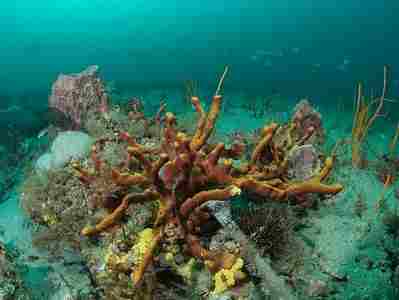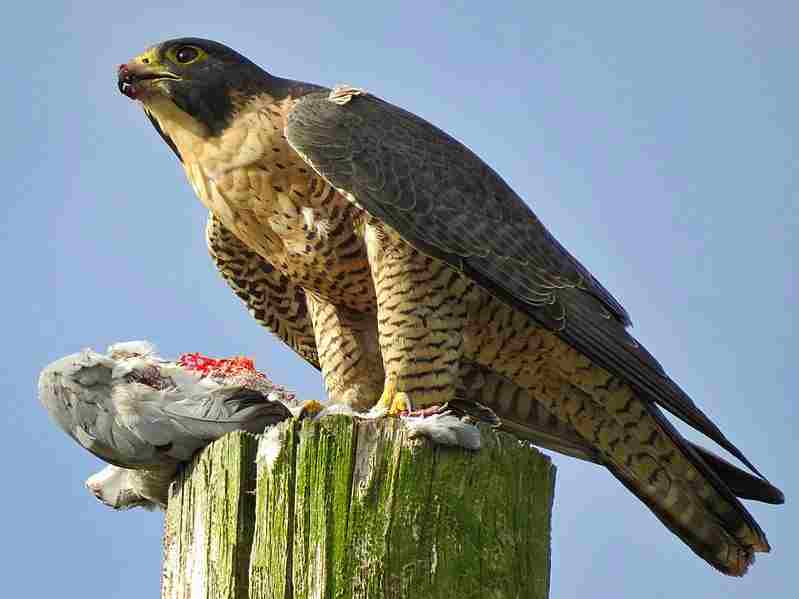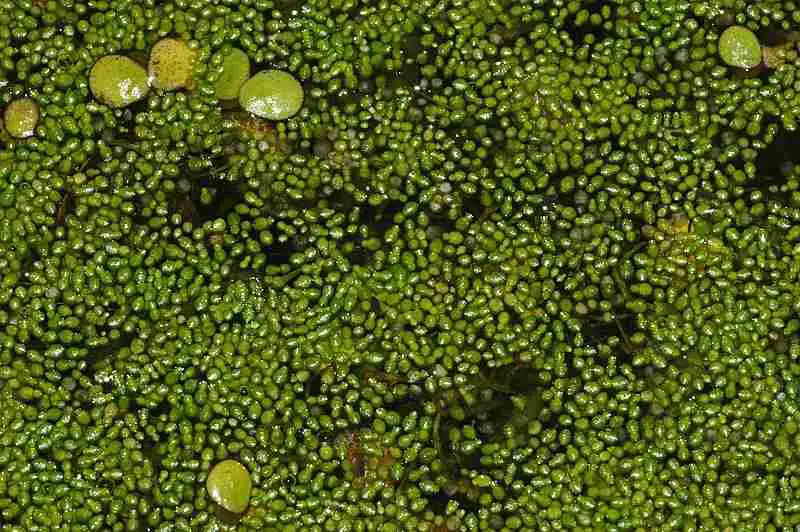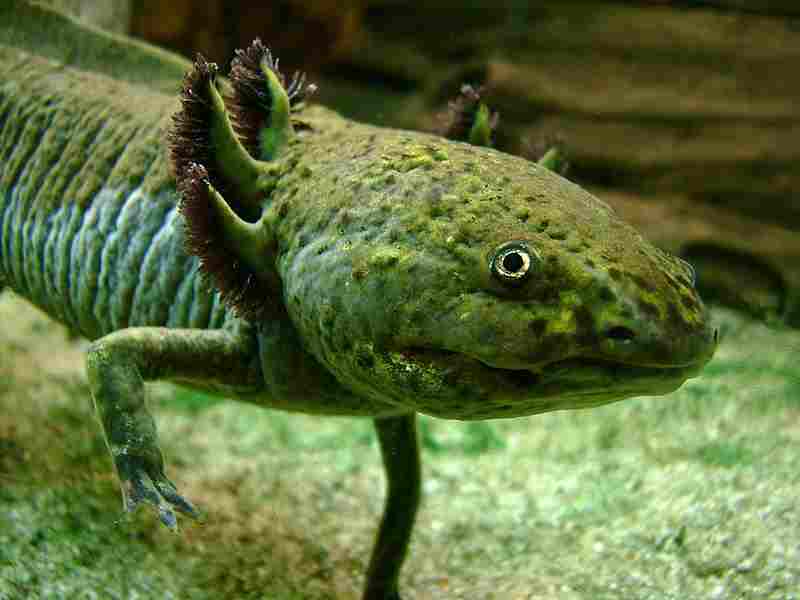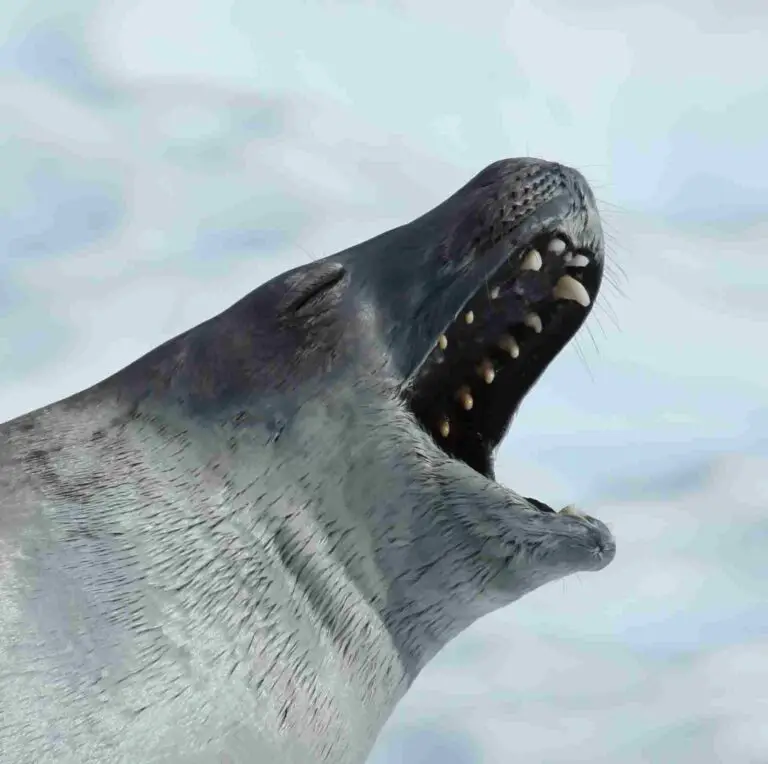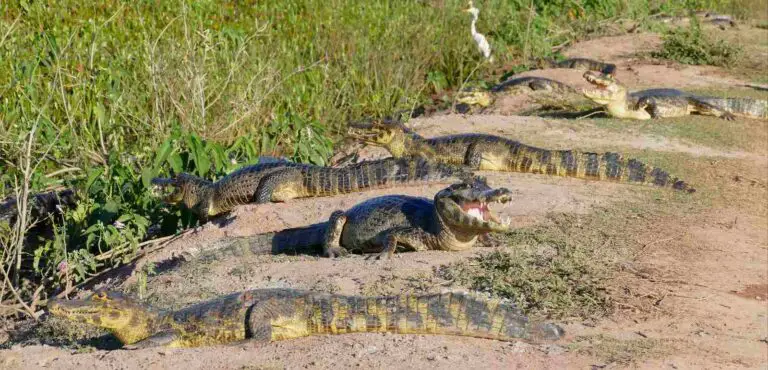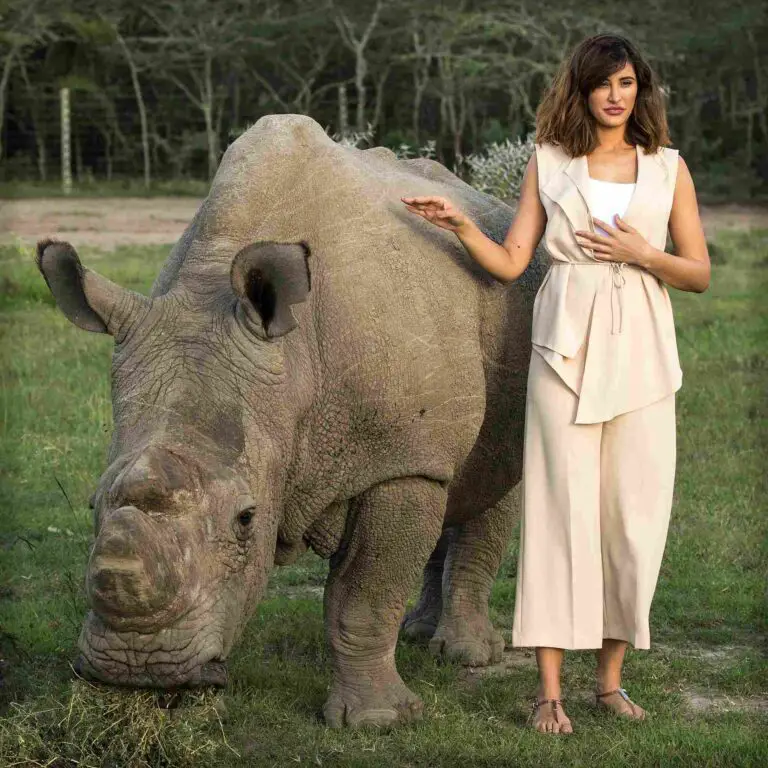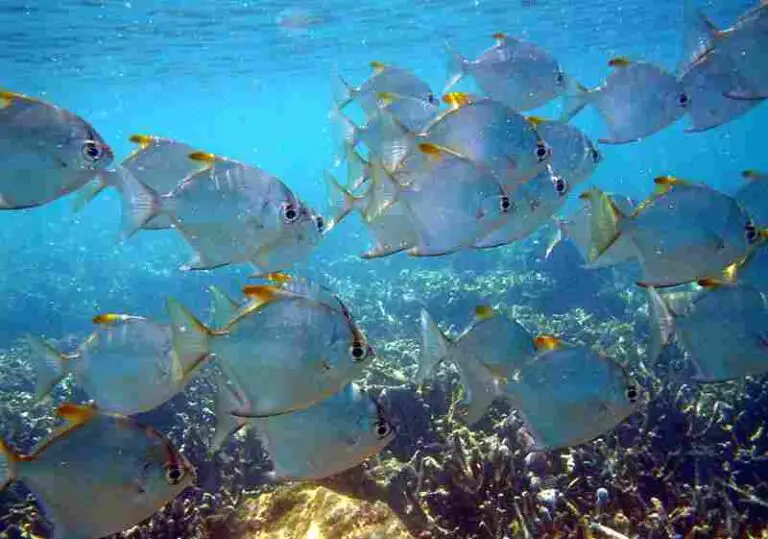Kelp Forest Food Chain | Kelp Forest Food Web
Kelp forest food chain is a linear sequence formed by feeding relations among producers, primary consumers, secondary consumers, tertiary consumers and decomposers. Kelp forest food web is a complex network of trophic interactions between organisms from different levels and 'food chains' in the ecosystem.
This article discusses kelp forest food chain and kelp forest food web in terms of their components and dynamics, as briefly outlined below;
*KELP FOREST FOOD CHAIN
1). Producers in the Kelp Forest: Biotic Components of the Kelp Forest Food Chain
Kelp forests can be described as vibrant underwater ecosystems that occur in cold, nutrient-rich and shallow coastal waters [17].
These aquatic ecosystems are supported by a variety of primary producers, which are mostly photosynthetic autotrophs.
Kelp forest producers have essential contributions to sustainability of the kelp forest's food chain and its internal dynamics. This section provides an overview of the producers in the kelp forest and their functions.
Kelp Forest Producers and Their Functions
Kelp forest producers include; giant kelp, phytoplankton like diatoms, red algae like Turkish towel, other green seaweeds, and microbes like autotrophic bacteria.
Giant kelp (Macrocystis) and other kelp species are among several autotrophs that are found in shallow coastal environments [8].
The giant kelp is a dominant producer in kelp forest ecosystems. It forms dense underwater "forests" that serve as habitat and shelter for a broad range of marine organisms. Kelp provides physical structure, and allows other organisms to attach and find refuge within its fronds.
Kelp also serves as a primary food source for various herbivores (and omnivores) in the kelp forest, such as sea urchins, marine snails, and some species of fish like opaleye [4]. These herbivores all graze on kelp fronds, thereby controlling the growth/diversity of kelps, and preventing overgrowth.
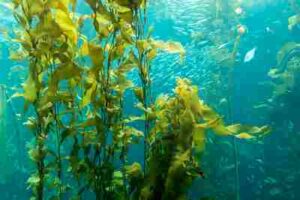
Phytoplankton (microscopic marine algae) are autotrophs that typically float close to the ocean's surface. They occupy the basal level of the marine food chain, meaning they contribute to primary production in various marine ecosystems including the kelp forest ecosystem. They are capable of performing photosynthesis, whereby light in solar radiation is converted into organic matter (biomass) and oxygen [18].
Phytoplankton include organisms like diatoms and coccolithophores that serve as a critical food source for filter-feeders and other low-level consumers like small fish, zooplankton, and some larval stages of marine animals. They are also indirectly useful to larger predators higher up in the food chain, that prey on the low-level consumers.
Red algae (such as coralline algae and Turkish towel [9]), are also autotrophic organisms that contribute to the overall diversity of the kelp forest ecosystem. They attach to rocks in shallow intertidal zones occupied by kelp forests, and provide additional substrate for other organisms to inhabit.
While they are not as prominent (as a food source) as kelp algae, some herbivores, like certain species of sea urchins and snails, may graze on red algae when other food materials are scarce.
Green seaweeds are macroalgal primary producers within the kelp forest ecosystem. They contribute to the diversity of the algal community, and boost overall species richness in coastal habitats.
These macroscopic algae are consumed by various herbivorous organisms, such as grazing fish and invertebrates.
Bacteria and other microorganisms are usually present in the water column and attached to substrates in the kelp forest. They participate in nutrient cycling and decomposition processes, contributing to the vitality of the ecosystem.
Some of these microbes, including cyanobacteria and chemosynthetic autotrophs, are primary producers. They produce energy from sunlight and/or inorganic raw materials, and in turn become food for filter-feeding organisms, like certain types of sponges.
Overview of Kelp Forest Producers and Their Functions
Five primary producers in the kelp forest include; giant kelp (Macrocystis), green seaweeds, red algae (like coralline algae and Turkish towel), phytoplankton (microscopic marine algae), and various other algal species. In rare cases, some vascular and non-vascular plants may also occur.
Plants in the kelp forest are mostly resilient and versatile halophytes with adaptations for anchorage and growth in shallow, wave influenced beaches and rocky shores.
Producers function as the foundation of the kelp forest food chain. They capture light energy from the sun using photosynthetic pigments, and convert it into organic matter. This organic matter in turn becomes the primary energy resource for herbivores and, subsequently, for occupants of higher trophic levels, including carnivores and omnivores.
Producers also act as ecosystem engineers that provide physical structure and a habitable microenvironment for many marine organisms, thereby contributing to the overall stability and biodiversity of the ecosystem.
2). Primary Consumers in the Kelp Forest
Primary consumers within the kelp forest are critical in their contribution to energy transfer and conservation (by recycling) of nutrients within this marine ecosystem. They are herbivorous organisms which rely on primary producers as a food source, the latter group in this case including kelp and other algal species.
An overview of primary consumers in the kelp forest and their functions within the food chain, is provided in this section.
Kelp Forest Primary Consumers and Their Functions
Kelp forest primary consumers are herbivores and omnivores like; sea urchins, turban snails, abalones, and omnivorous sea stars like the granulated sea star.
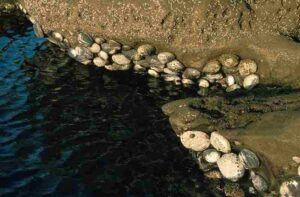
Sea urchins are prominent primary consumers in kelp forests. They mainly feed on kelp blades, stipes, and holdfasts [11]. By grazing on kelp, they help to regulate the growth of these fast-growing algae, and prevent resource depletion or environmental degradation in shallow coastal terrains.
Within the food chain structure, sea urchins function as a link between primary producers (algae) and non-herbivorous consumers in higher trophic levels. They are a critical source of nutrients and energy for various secondary consumers, such as carnivorous fish and sea otters.
Turban snails and abalones are both herbivorous mollusks that also feed on macroalgae within the kelp forest ecosystem. They graze on kelp fronds and are instrumental in shaping the distribution of algal beds.
These herbivores are primary consumers that directly feed on kelp. They are in turn preyed upon by secondary consumers, including green crabs, octopuses, and carnivorous sea stars.
Certain species of sea stars in the kelp forest ecosystem also function as primary consumers. These are usually omnivorous and opportunistic species, and may be scavengers that exploit a broad range of organic materials as food. An example is the granular sea star which feeds on algal litter, thereby contributing to the regulation of autotrophic populations.
Sea stars that act as primary consumers, help to maintain the balance between producers and herbivores in the ecosystem. They subsequently serve as a food source for predators in higher trophic levels.
Overview of Kelp Forest Primary Consumers and Their Ecological Functions
Primary consumers in the kelp forest, such as sea urchins, turban snails, abalones, and certain sea stars, are effective as natural regulators of primary producer populations.
They help to prevent overgrowth of kelp, and facilitate the transfer of energy to higher trophic levels. If the populations of these primary consumers are altered or disrupted, it can have measurable effects on the entire kelp forest ecosystem, as seen when overpopulation and overgrazing by sea urchins lead to kelp devastation [12].
3). Secondary Consumers in the Kelp Forest: Biotic Components of the Kelp Forest Food Chain
Secondary consumers in the kelp forest are fully involved in the transfer of energy and nutrients within this marine habitat.
They occupy a higher trophic level than the primary consumers, and feed mainly on these herbivores along with some primary producers. This section discusses secondary consumers in the kelp forest and their functions as biotic components of the food chain.
Secondary Consumers in the Kelp Forest
Examples of secondary consumers in the kelp forest are; sea otters, octopuses, and sea stars.
Sea otters are distinctive marine mammals and are classified as secondary consumers in the kelp forest. They prey heavily on sea urchins, which are primary consumers that graze on kelp [7].
Through their activities, sea otters help regulate the population of sea urchins. By preying on sea urchins, they protect kelp from overgrazing by these invertebrates, thereby promoting the health and growth of the entire kelp forest. Sea otters are a critical element for maintaining the equilibrium of the ecosystem.
Octopuses are molluscan secondary consumers that occasionally traverse in the kelp forest ecosystem. They are invertebrates and can be described as cepaholopod (eight-armed) mollusks [13], which have a diverse diet that may include other mollusks, crustaceans, fish.
In the food chain, octopuses help regulate the populations of various kelp forest invertebrates and small fish. They contribute to the overall equilibrium and diversity of the ecosystem, by controlling the abundance of their prey.
Some species of sea stars are active secondary consumers due to their predatory behavior. They may feed on other invertebrates, including mollusks like mussels and abalones, which are primary consumers that graze on algae.
These sea stars help regulate the populations of herbivorous invertebrates that they consume within the kelp forest. Through this means, they indirectly influence the abundance of kelp and other algae.
Functions of Kelp Secondary Consumers as Components of the Food Chain
As lower predators, secondary consumers are instrumental in regulating the populations of both primary consumers (like sea urchins) and other secondary consumers (like squids and small octopuses).
They help to maintain the balance of resources and demands within the kelp forest ecosystem, by preventing the overconsumption of primary producers (kelp) by primary consumers and conserving the productivity and diversity of the ecosystem.
Any disruption of the populations of secondary consumers like sea otters can lead to unchecked sea urchin populations, ultimately resulting in the overgrazing of kelp and potential ecosystem collapse. This indicates that secondary consumers are key biotic components in the trophic dynamics of the kelp forest, which ensure the long-term sustainability of this unique marine habitat.
4). Tertiary Consumers in the Kelp Forest
Tertiary consumers in the kelp forest are organisms that occupy an even higher trophic level than secondary consumers.
They are considered critical in their role toward the predatory regulation of organic populations of lower trophic levels, and contribute to the complex dynamics of this marine ecosystem. An elaborate overview of tertiary consumers in the kelp forest and their functions within the food chain is given in this section.
Examples and Basic Roles of Kelp Forest Tertiary Consumers
Examples of kelp forest tertiary consumers are; sea lions and sharks. In studies where a fifth level for quaternary consumers is included, it may include species like orcas, great white sharks, and alligators. However in the absence of such a level, tertiary consumers will serve as the apex predators.
Sea lions are among the tertiary consumers in the kelp forest ecosystem. They feed mainly on secondary consumers like fish and may also consume some secondary consumers like squids [10].
Through predation, sea lions help to control the populations of both secondary consumers and some primary consumers. Their predatory behavior influences the abundance and distribution of various species within the kelp forest.
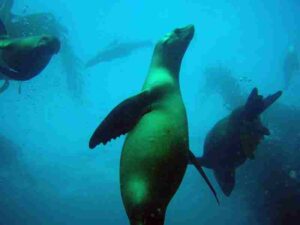
Sharks, including species such as leopard sharks, are classified as tertiary consumers in shallow coastal habitat like the kelp forest. They generally have a diverse diet that may include other fish, and various marine invertebrates.
As top predators in the kelp forest ecosystem, sharks regulate the populations of various species within their territory, including both secondary consumers and primary consumers. Their presence helps to prevent overpopulation of lower trophic levels, and contributes to the overall stability of the ecosystem.
Functions of Tertiary Consumers as Components of the Food Chain
Tertiary consumers in the kelp forest are high-level predators, and their role is multifaceted, including aspects like population control, biodiversity maintenance, and regulation of energy flow.
With regards to population control, tertiary consumers help regulate the abundance and spatial distribution of both secondary consumers (like small carnivorous fish, octopuses) and some primary consumers (including herbivorous mollusks and sea urchins). By preying on these organisms, they prevent overpopulation, overgrazing, excessive competition and species exclusion, each of which could have severe effects on the entire ecosystem.
By the same means, tertiary consumers influence the diversity and composition of species within the kelp forest. They exert predation pressures that drives adaptation and helps create ecological niches for various species, thereby contributing to overall biodiversity.
Lastly, tertiary consumers control the flow of energy through the food web by determining which species thrive and which populations are kept in check. This mechanism ensures that energy is distributed in an efficient and sustainable manner within the ecosystem.
Overview of Kelp Forest Tertiary Consumers and Their Ecological Role(s)
Tertiary consumers in the kelp forest are organisms that feed on secondary consumers (like fish, octopuses) and may also consume some primary consumers (like sea urchins).
Roles played by kelp forest tertiary consumers include regulating the populations of lower trophic levels, maintaining biodiversity, and controlling the flow of energy within the ecosystem.
5). Decomposers in the Kelp Forest: Biotic Components of the Kelp Forest Food Chain
Decomposers are a critical component of the kelp forest ecosystem. They have a vital function that involves recycling nutrients and breaking down organic materials, to ensure that all forms of organic waste are efficiently returned to the ecosystem for reuse.
Here, a discussion of decomposers in the kelp forest food chain, and their functions is provided.
Examples and Functions of Decomposers in the Kelp Forest
Decomposers in the kelp forest include saprophytic microorganisms like bacteria, as well as filter-feeders and detritivores like sponges and sea cucumbers. Each of these examples is further highlighted.
Bacteria are essential decomposers that inhabit the kelp forest ecosystem [2]. They break down the remains of dead kelp, as well as the remains and wastes of kelp forest heterotrophs, into smaller organic particles, or simpler inorganic products. This implies that they are instrumental for initiating or/and executing the decomposition process.
As primary decomposers, bacteria convert complex organic molecules in remains and waste materials, into simpler compounds. These simpler compounds can then be utilized in various ways by other organisms in the ecosystem.
Sponges are filter-feeding invertebrates that are instrumental in capturing small organic particles from the water column, including those generated during the decomposition of kelp and the release of waste by heterotrophs.
While sponges are not traditional decomposers, they indirectly contribute to the recycling of organic resources by consuming and processing small particulates from the water.
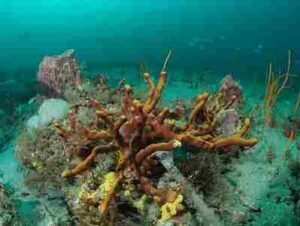
Sea cucumbers are efficient detritivores and scavengers that feed on remnants and waste organic material on the kelp forest floor. They consume a wide range of organic matter, including animal and plant-derived detritus.
With respect to their trophic role, sea cucumbers serve as an integral part of the kelp forest's biodegradation process. They break down organic substrates into smaller pieces, further facilitating decomposition and nutrient release.
Functions of Decomposers as Components of the Food Chain
Kelp forest decomposers, especially bacteria, are crucial in the recycling of nutrients locked within organic waste material. By breaking down and converting complex organic compounds into simpler products, they release essential nutrients like carbon, sulfur, nitrogen, and phosphorus back into the water column and sediments, for reuse.
Sea cucumbers, in particular, help to manage the accumulation rate of detritus on the kelp forest floor. By consuming organic substrates, they prevent excessive build-up, which could lead to adverse effects like pathogen multiplication, oxygen depletion and severe water pollution.
Lastly, decomposers indirectly support higher trophic levels in the kelp forest, by recycling nutrients and making the same available to primary producers (like algae) through nutrient-rich water and sediments.
Inquiry into the Status of Sea Urchins as Decomposers in Kelp Forests
Sea urchins are not typically classified as decomposers. They are more accurately placed as primary consumers because they feed primarily on live kelp and other algae, as well as organic substrates on rocks.
While they consume organic material, their role is not focused on breaking down waste materials into simpler reusable forms, which is a primary function of decomposers like bacteria.
*KELP FOREST FOOD WEB AS AN INTERCONNECTION OF MULTIPLE FOOD CHAINS
The kelp forest food web is a complex ecologic structure formed by intricate interconnections of various species and organic classes, on the basis of feeding relations. This structure can be dissembled to yield identifiable linear sequences of energy transfer, which may otherwise be called food chains.
Here, three of such chains are briefly discussed, and their contributions to the formation of the web structure through recurrence and linking of organisms across multiple chains, are also highlighted.
1). Food Chain 1: A Component of the Kelp Forest Food Web
Levels and Organisms: Giant kelp, diatom, chlamydomonas, oarweed (Trophic Level 1)→sea urchin, opaleye, abalone (Trophic Level 2)→sea otter, horned shark (Trophic Level 3)→orca (Trophic Level 4)
*Trophic Level 1: Primary Producers
Giant kelp usually serves as a foundational primary producer in the kelp forest ecosystem. Through photosynthetic activity, it harnesses sunlight to produce energy and oxygen. Giant kelp provides physical fortification and microhabitat for multiple species in the kelp forest.
Diatoms, a type of microscopic algae, are primary producers that also carry out photosynthesis. They are an essential contributor to the kelp forest's primary productivity, and help constitute the base of the food web.
Chlamydomonas, another type of phytoplankton (and a unicellular green algae [5]), functions as a primary producer by photosynthesizing and transforming solar energy (as well as inorganic chemical materials) into organic compounds. It supplements the diversity of primary producers.
Oarweed (Laminaria), a brown algae species, is yet another primary producer in the kelp forest ecosystem. It contributes to the overall richness of the primary producer community.
*Trophic Level 2: Primary Consumers
Sea urchins, as primary consumers, are known to consume giant kelp and other macroalgae. They are instrumental for regulating the abundance of primary producers in the kelp forest.
Opaleye fish are herbivorous primary consumers that graze on macroalgae, including kelp [1]. They participate in controlling the population of primary producers.
Abalones, herbivorous marine mollusks, consume kelp and other macroalgae, as well as some microalgal species. They help to maintain a balance of resources between primary producers and primary consumers.
*Trophic Level 3: Secondary Consumers
Sea otters are carnivorous secondary consumers in the kelp forest ecosystem. They primarily prey on sea urchins, which are primary consumers. Sea otters are vital in controlling sea urchin populations, thereby indirectly protecting kelp beds from destruction through excessive herbivory.
Horned sharks are secondary consumers that inhabit the kelp forest. They primarily feed on smaller fish (like opaleye) and invertebrates in the ecosystem. Their activities contribute to the overall equilibrium of the kelp forest food web.
*Trophic Level 4: Tertiary Consumers
Orcas, or killer whales, are apex predators in the kelp forest ecosystem. While not exclusive to kelp forests, they occupy the highest trophic level in many marine habitats that include shallow coastal environments. Orcas are opportunistic feeders and may consume a variety of marine life, including other marine mammals like sea otters and sea lions. Their presence influences the dynamics of the entire ecosystem.
2). Food Chain 2
Levels and Organisms: Dinoflagellates, coccolithophores, sea lettuce, bull kelp (Trophic Level 1)→krill, halfmoon, sea urchin (Trophic Level 2)→squid, octopus, sea otter, albatross (Trophic Level 3)→sea lion, bald eagle (Trophic Level 4)→orca (Trophic Level 5)
*Trophic Level 1: Primary Producers
Dinoflagellates are microscopic, planktonic organisms. They can be described as primary producers that utilize photosynthetic mechanisms to convert sunlight into chemical energy. These organisms are an essential part of the kelp forest's phytoplankton community.
Coccolithophores are another type of phytoplankton that perform photosynthesis. They contribute to the primary productivity of the kelp forest's marine ecosystem by converting renewable energy and other abiotic resources to biomass.
Sea lettuce (Ulva) is a green algae that often occurs in the kelp forest. It functions as a primary producer by harnessing sunlight and nutrients for growth.
Bull kelp (Nereocystis) is a large brown algae species [15] and a prominent primary producer in the kelp forest. It serves as both an ecosystem engineer (by creating habitat) and a food source for various organisms.
*Trophic Level 2: Primary Consumers
Krill are small, shrimp-like crustaceans that feed on phytoplankton such as coccolithophores and dinoflagellates. They are herbivorous primary consumers that are highly instrumental in transferring energy from phytoplankton to heterotrophs in higher trophic levels.
Halfmoons are herbivorous fish that graze on macroalgae and seaweed, including sea lettuce and bull kelp. They are important for maintaining a balance between primary producers and consumers in the kelp forest.
Sea urchins, herbivorous marine animals, also appear in this food chain. They consume kelp and algae, contributing to the control of primary producer populations.
*Trophic Level 3: Secondary Consumers
Squids are carnivorous cephalopods that prey on animals like small fish and planktonic organisms. They are secondary consumers, deriving energy from krill and small fish, among other lower consumers in the kelp forest ecosystem.
Octopuses are another group of cephalopod predators found in the kelp forest. They feed on various prey items, including crustaceans and small fish.
Sea otters, which were also mentioned in Food Chain 1, are mammalian secondary consumers that primarily feed on sea urchins and fish. Their predation helps regulate sea urchin populations, and is indirectly beneficial to primary producers like kelp.
Albatrosses are seabirds that inhabit shallow coastal zones, including the kelp forest surroundings. They are primarily piscivorous (fish-eaters) [6], and some species may also feed on squid. Their presence links the marine ecosystem to the avian ecosystem.
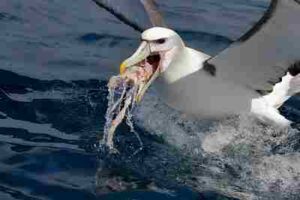
*Trophic Level 4: Tertiary Consumers
Sea lions are tertiary consumers in this food chain. They primarily feed on fish and other marine animals, including squid. They are an integral part of the kelp forest's marine mammal community.
Bald eagles are apex predators in the avian world and are tertiary consumers in this ecosystem. They mainly feed on fish, sea birds, and, in some cases, carrion. Their presence connects the marine ecosystem to the terrestrial ecosystem.
*Trophic Level 5: Quaternary Consumers
Orcas, mentioned previously in Food Chain 1, are apex predators at the highest trophic level in the kelp forest ecosystem. They are opportunistic feeders, consuming a variety of marine mammals, including sea lions. Their role influences the overall equilibrium of consumption and production in the ecosystem.
*Recurrence of Organisms
Sea urchins appear in both Food Chain 1 and Food Chain 2. Their presence underscores their significance as both consumers and a food source for secondary consumers like sea otters.
Sea otters and orcas are also recurring organisms that are found in both Chains 1 and 2.
By operating in both chains, these organisms serve as trophic nodal points that link one food chain to another, thereby establishing interconnections that build out to create the intricate ecological structure called the food web.
3). Food Chain 3: A Component of the Kelp Forest Food Web
Levels and Organisms: Cyanobacteria, giant kelp, sargassum, Turkish towel (Trophic Level 1)→turban snail, sea urchin (Trophic Level 2)→rockfish, sea otter, kelp gull, penguin (Trophic Level 3)→seal (Trophic Level 4)→great white shark, alligator (Trophic Level 5)
*Trophic Level 1: Primary Producers
Cyanobacteria, also known as blue-green algae, are photosynthetic microorganisms. They serve as primary producers in the kelp forest ecosystem, using photosynthesis to convert sunlight into chemical energy.
Giant kelp is one of the dominant brown algae in the kelp forest and a primary producer. It forms towering underwater beds referred to as kelp forests, providing habitats and a means of sustenance for various organisms.
Sargassum is another type of brown algae found in the kelp forest. It contributes to primary production and helps create a diverse habitat.
Turkish towel (Gigartina), is a type of red algae that adds to the diversity of primary producers in the kelp forest, and utilizes photosynthesis to generate energy and create biomass.
*Trophic Level 2: Primary Consumers
Turban snails are herbivorous gastropods that graze on kelp blades and other algal materials. They are primary consumers, consuming primary producers like giant kelp and sargassum.
Sea urchins, as mentioned in previous food chains, are also primary consumers. They feed on kelp and contribute to controlling kelp populations.
*Trophic Level 3: Secondary Consumers
Rockfish are carnivorous fish that prey on smaller fish, mollusks, crustaceans, and other organisms in the kelp forest ecosystem. They occupy the secondary consumer level.
Sea otters, previously mentioned in Food Chains 1 and 2, are secondary consumers that primarily feed on sea urchins, thereby contributing to the regulation of urchin populations.
Kelp gulls are seabirds found in kelp forest environments. They feed on a variety of prey, including fish, and may scavenge for food in the intertidal zone.
Penguins are seabirds known for their piscivorous (fish-eating) habits. They prey on small fish and krill within the kelp forest's marine ecosystem.
*Trophic Level 4: Tertiary Consumers
Seals, relatives of sea lions, and belonging to the category of semi-aquatic mammals known as pinnipeds [3], occupy the tertiary consumer level. They are carnivorous marine dwellers that feed on various prey, including fish and cephalopods (like squid).
*Trophic Level 5: Quaternary Consumers
Great white sharks are apex predators in the kelp forest ecosystem. They are quaternary consumers that feed on marine mammals, including seals. Their presence influences the dynamics of the ecosystem.
While alligators are typically found in freshwater environments, in some rare cases, they may venture into coastal areas with kelp forests, where they function as quaternary consumers by preying on animals such as seals and small sharks.
*Recurrence of Organisms
Sea urchins appear once again in Food Chain 3, functioning as primary consumers by consuming kelp and algae. This recurrence emphasizes their ecological significance in the kelp forest, as they are a common link between primary producers and higher trophic levels.
Giant kelp can be found in Chains 1 and 3 recurrently
Sea otter occurs in all three Food Chains
By occurring in multiple chains, these organisms contribute to ecologic resilience in the kelp forest, and create dense trophic networks that are the basis of the food web.
Structure of the Food Web in Aquatic Habitats
The structure of a food web in aquatic habitats like kelp forests is complex and interconnected, consisting of multiple food chains that overlap and interact.
Each food chain represents a linear series of trophic levels where organisms transfer energy by photosynthesizing and feeding on one another. In reality, these chains are not isolated sequences; but are interlinked to form a more intricate web-like structure.
This section discusses how individual food chains and their component organisms interlink to create the structure of a kelp forest food web, by citing organic compositions of trophic levels, interconnectedness, and redundancy.
-Primary Producers
Giant Kelp, Sargassum, Cyanobacteria, Turkish Towel; are among the primary producers that use photosynthesis to convert sunlight into energy. They form the foundation of the kelp forest food web.
-Primary Consumers
Herbivorous Snails and Sea Urchins; represent organisms that consume primary producers, including giant kelp and other algae. They are the first consumers in the food web.
-Secondary Consumers
Rockfish and Other Carnivorous Fish; feed on herbivores like snails and sea urchins, forming a secondary level of consumers.
Sea otters primarily feed on sea urchins, regulating the latter's populations. They are also secondary consumers.
Kelp Gulls and Penguins; are seabirds that feed on a variety of prey, including fish and marine invertebrates, whereby they contribute to the secondary consumer level.
-Tertiary Consumers
Seals are carnivorous marine mammals that prey on various species of fish, and cephalopods like squid.
-Quaternary Consumers
Great White Sharks are apex predators which occupy the highest trophic level in the kelp forest food web. They feed on marine mammals, including seals.
-Decomposers
Bacteria are microbial decomposers that are crucial in breaking down organic waste matter, from which they recycle nutrients back into the ecosystem. They help to maintain the overall productivity and wellbeing of the kelp forest.
-Detritivores
Detritivorous organisms, such as marine worms, some benthic crustaceans and annelids (which are also abundant in coral reefs), may be found in kelp forest zones where they consume partially-decomposed plant and animal litter, further contributing to the recycling of nutrients.
The Interconnectedness of Food Chains that Constitute the Kelp Forest Food Web
Food chains within the kelp forest are interlinked because many organisms have evolved to exploit multiple food sources. For example; a sea otter can feed on sea urchins, snails, and various fish species, making it part of several distinguishable food chains.
Omnivorous species, like some crustaceans, echnioderms, fish and seabirds, can feed at different trophic levels, functioning in multiple consumer capacities, and adding complexity to the interconnections.
These recurring organisms, such as sea urchins, appear in various food chains as primary or secondary consumers, highlighting their importance in connecting primary producers to higher trophic levels and facilitating upward flow of energy resources.
*Complexity and Redundancy in the Kelp Forest Food Web
The food web in kelp forests is characterized by its complexity and redundancy. If one species is impacted by changes, such as overexploitation or disease, there are often alternative prey sources and predators, which helps maintain the equilibrium and continuity of the ecosystem.
The redundancy in food sources and consumers enhances the resilience of the kelp forest ecosystem to environmental fluctuations and other disturbances.
Relationship Between the Kelp Forest Food Web and Other Marine Food Webs
The relationships between the food webs of kelp forests, coastal rocky shores, and abyssal zones are fascinating instances of how marine ecosystems vary in structure, composition and function based on their specific environmental conditions and the organisms that inhabit them.
This section briefly explores the key differences and connections between these three marine habitats, by highlighting some basic constituents of their respective food webs.
*Kelp Forests
Primary Producers include giant kelp and other macroalgae which are dominant autotrophs that use photosynthesis to convert light and inorganic reagents into bioenergy.
Primary Consumers here are organisms like sea urchins and herbivorous fish that feed on primary producers.
Secondary Consumers include carnivorous fish, sea otters, and seabirds.
Tertiary Consumers are represented by marine mammals like seals and sea lions which occupy this trophic level.
Apex Predators include great white sharks that prey on all lower consumers in kelp forests.
*Coastal Rocky Shores
Primary Producers in the intertidal zone, where terrestrial environments and marine terrains meet, include algae (like green, red, and brown algae) as well as some seagrass species.
Primary Consumers are herbivorous snails like limpets, and small phytoplankton-feeding crustaceans like barnacles that attach to rocky substrates and consume algae.
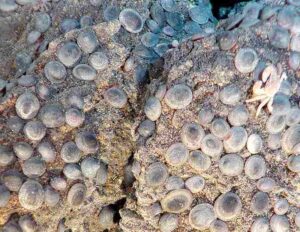
Secondary Consumers include small carnivorous fish and shorebirds are secondary consumers.
Tertiary Consumers are represented by larger predatory fish and marine mammals like seals that can be classified within this level.
*Abyssal Zones
Primary Producers in the abyssal zone, where light availability is low, are mostly chemosynthetic bacteria [14] and some bioluminescent organisms that use chemical energy from hydrothermal vents.
Primary Consumers are organisms like giant tube worms and various invertebrates feed on bacteria and autotrophic detritus.
Secondary Consumers include predatory invertebrates, deep-sea fish, and some cephalopods.
Tertiary Consumers or apex predators in abyssal zones include some species of sharks and other large, deep-sea fish.
*Key Relationships and Contrasts
The relationships and contrasts between kelp forest foods webs and those of other marine habitats, can be evaluated in terms of factors like primary production, biodiversity, predator-prey dynamics, and geographic connectivity, as shown in the following table;
Comparison Criterion | Kelp Forest | Coastal Rocky Shore | Abyssal Zone |
Primary Production | Kelp forests rely on photosynthesis and receive sunlight, making them dependent on shallow, well-lit waters. | Coastal rocky shores receive sunlight but are subject to extreme tidal fluctuations. | Abyssal zones mostly rely on chemosynthesis due to the absence of sunlight. This alternative process usually occurs around hydrothermal vents or cold seeps. |
Biodiversity | Kelp forests are highly diverse with complex food webs due to the abundance of primary producers. | Coastal rocky shores have moderate biodiversity that is influenced by the seasonal impact of tidal cycles. | Abyssal zones have unique and often specialized organisms that are adapted to extreme pressure, low temperature, and darkness. |
Predator-Prey Dynamics | Kelp forest predators, like sea otters and sharks, often have specific prey, and changes in their populations can impact the structure of the ecosystem. | Coastal rocky shores experience constant shifts in predator-prey interactions due to tidal changes. | Abyssal zone predators are a distinct group, and possess unique adaptations for capturing prey in the deep-sea darkness. |
Geographic Connectivity | Kelp forests and coastal rocky shores are often found in proximity, allowing for some species to traverse both habitats. | Abyssal zones are distinct (due to their depth) and less interconnected with other marine habitats. | |
While all three marine habitats support diverse ecosystems, their food webs differ significantly as a result of variations in factors like primary production, environmental conditions, and species composition.
Similarity Between Kelp and Chemosynthetic Bacteria of Hydrothermal Vent Environs
Kelp and chemosynthetic bacteria found near hydrothermal vents are similar in some of their basic attributes, but they also have significant differences due to their biological mechanisms, ecological roles, and the environments in which they thrive. A comparison of these two types of organisms is provided here.
-Kelp and Chemosynthetic Bacteria Similarities
The main similarity between kelp and chemosynthetic bacteria is their autotrophic capability, which enables them produce chemical energy from inorganic raw materials, and support heterotrophic populations.
Both kelp and chemosynthetic bacteria are primary producers within their respective ecosystems. This means that they are responsible for converting energy from non-living sources into organic matter that is consumed as food by other organisms.
While their respective sources of energy differ, both kelp and chemosynthetic bacteria are autotrophic, meaning they can create their own food. Kelp utilizes the mechanism of photosynthesis, harnessing light energy from the sun, while chemosynthetic bacteria rely on chemical reactions involving compounds like hydrogen sulfide (H2S), in the absence of sunlight [16].
Both kelp macroalgae and chemosynthetic bacteria are critical in supporting the ecosystems that they inhabit. Kelp forests are known for their high biodiversity, and provide an inhabitable environment as well as food for numerous species. Chemosynthetic bacteria are foundational to the food chains of deep-sea ecosystems, where they serve as the basic bioenergy source, and support various heterotrophic life forms.
-Differences between Kelp and Chemosynthetic Bacteria
Differences between kelp and chemosynthetic bacteria can be cited in their energy sources, habitats, specific ecological roles, and respective impacts on biodiversity. This is summarized in the following table;
Comparison Criterion | Kelp | Chemosynthetic Bacteria |
Energy Source | Kelp relies on sunlight for photosynthesis, which restricts it to shallow, sunlit waters that typically occur in coastal areas. | Chemosynthetic bacteria thrive in extreme environments such as hydrothermal vents or cold seeps, in the deep sea where sunlight cannot penetrate. They derive energy from chemical reactions that involve compounds like hydrogen sulfide, which is abundant in these deep-sea areas. |
Habitat | Kelp primarily inhabits coastal regions with access to sunlight, where it grows rapidly to form extensive underwater forests. | Chemosynthetic bacteria are found in the extreme terrain of the deep sea, near hydrothermal vents or cold seeps, where high temperatures and high-pressure conditions are prevalent. |
Ecological Role | Kelp, as macroalgae, functions as an ecosystem engineer and a food source for various marine organisms, including herbivores, filter feeders, and carnivores. | Chemosynthetic bacteria often constitute the foundation of food webs in deep-sea ecosystems. They provide sustenance for organisms such as clams, giant tube worms, and other vent-dwelling creatures. |
Biodiversity Impact | Kelp forests are known for their high biodiversity, and support a broad range of diverse species, including small invertebrates and large marine mammals. Such organic diversity is indicative of the productivity of kelp and associated photosynthetic algae. | Deep sea ecosystems close to hydrothermal vents are characterized by unique and often specialized species that have evolved to tolerate extreme conditions, but they generally have lower overall biodiversity compared to kelp forests. These species are ultimately dependent on autotrophs like chemosynthetic bacteria. |
Although kelp and chemosynthetic bacteria are both primary producers and contribute to sustenance of life in marine ecosystems, they differ significantly in terms of their energy sources, habitats, specific ecological roles, and impacts on biodiversity. These differences reflect their adaptations to distinct environmental niches within the marine biome, and their respective capacities as contributors to food chains/webs.
Conclusion
The kelp forest food chain is made up of trophic levels and organisms like;
1. Producers (Level 1)
2. Primary Consumers (Level 2)
3. Secondary Consumers (Level 3)
4. Tertiary Consumers (Level 4)
5. Decomposers (Saprophytes and Detritivores that Recycle Waste)
The kelp forest food web can be simplified by distinguishing feeding relationships that can be ordered into a continuous linear sequence, such as the following;
1. Food Chain 1: Giant kelp, diatom, chlamydomonas, oarweed (Trophic Level 1)→sea urchin, opaleye, abalone (Trophic Level 2)→sea otter, horned shark (Trophic Level 3)→orca (Trophic Level 4)
2. Food Chain 2: Dinoflagellates, coccolithophores, sea lettuce, bull kelp (Trophic Level 1)→krill, halfmoon, sea urchin (Trophic Level 2)→squid, octopus, sea otter, albatross (Trophic Level 3)→sea lion, bald eagle (Trophic Level 4)→orca (Trophic Level 5)
3. Food Chain 3: Cyanobacteria, giant kelp, sargassum, Turkish towel (Trophic Level 1)→turban snail, sea urchin (Trophic Level 2)→rockfish, sea otter, kelp gull, penguin (Trophic Level 3)→seal (Trophic Level 4)→great white shark, alligator (Trophic Level 5)
References
1). Behrens, M. D.; Lafferty, K. D. (2012). "Geographic variation in the diet of opaleye (Girella nigricans) with respect to temperature and habitat." PLoS One. 2012;7(9):e45901. Available at: https://doi.org/10.1371/journal.pone.0045901. (Accessed 30 September 2023).
2). Bengtsson, M.; Sjøtun, K.; Lanzén, A.; Øvreås, L. (2012). "Bacterial diversity in relation to secondary production and succession on surfaces of the kelp Laminaria hyperborea." The ISME Journal 6(12). Available at: https://doi.org/10.1038/ismej.2012.67. (Accessed 30 September 2023).
3). Berta, A.; Churchill, M.; Boessenecker, R. W. (2018). "The Origin and Evolutionary Biology of Pinnipeds: Seals, Sea Lions, and Walruses." Annual Review of Earth and Planetary Sciences 46(1). Available at: https://doi.org/10.1146/annurev-earth-082517-010009. (Accessed 30 September 2023).
4). Bredvik, J. J.; Boerger, C. M.; Allen, L. G. (2011). "Age and Growth of Two Herbivorous, Kelp Forest Fishes, the Opaleye (Girella nigricans) and Halfmoon (Medialuna californiensis)." Bulletin Southern California Academy of Sciences 110(Apr 2011):25-34. Available at: https://doi.org/10.3160/0038-3872-110.1.25. (Accessed 30 September 2023).
5). Cheloni, G.; Slaveykova, V. I. (2020). "Morphological plasticity in Chlamydomonas reinhardtii and acclimation to micropollutant stress." Aquatic Toxicology 231:105711. Available at: https://doi.org/10.1016/j.aquatox.2020.105711. (Accessed 30 September 2023).
6). Croxall, J.; North, A. W.; Prince, P. A. (1988). "Fish prey of the Wandering Albatross Diomedea exulans at South Georgia." Polar Biology 9(1):9-16. Available at: https://doi.org/10.1007/BF00441760. (Accessed 30 September 2023).
7). Dean, T. A.; Bodkin, J. L.; Jewett, S. C.; Monson, D. H.; Jung, D. (2000). "Changes in sea urchins and kelp following a reduction in sea otter density as a result of the Exxon Valdez oil spill." Marine Ecology Progress Series 199:281-291. Available at: https://doi.org/10.3354/meps199281. (Accessed 30 September 2023).
8). Graham, M. H.; Vásquez, J. A.; Buschmann, A. H. (2007). "Global ecology of the giant kelp Macrocystis: From ecotypes to ecosystems." Oceanography and Marine Biology 45:39-88. Available at: https://www.semanticscholar.org/paper/GLOBAL-ECOLOGY-OF-THE-GIANT-KELP-MACROCYSTIS-%3A-FROM-Graham-Vásquez/3f927f3ba062812c649186b20b5a709af775dc8b. (Accessed 30 September 2023).
9). Johnson, R. B.; Nicklason, P. M.; Armbruster; L. C.; Sommers, F.; Kim, S.-K.; Marancik, D.; Jee, J.; Gadberry, B. A.; Colt, J. E. (2020). "Addition of the red macroalgae Turkish Towel Chondracanthus exasperates and taurine improves the performance of alternative plant‐based feeds for juvenile sablefish Anoplopoma fimbria " Hindawi, Aquaculture Research 51(8). Available at: https://doi.org/10.1111/are.14654. (Accessed 30 September 2023).
10). Kastelein, R. A.; Schooneman, N. M.; Jennings, N.; Wiepkema, P. R. (2000). "Food consumption and growth of California sea lions (Zalophus californianus californianus)." Zoo Biology 19(19):143-159143. Available at: https://doi.org/10.1002/1098-2361(2000)19:23.0.CO;2-O. (Accessed 30 September 2023).
11). Lauzon-Guay, J.-S.; Scheibling, R. E. (2007). "Behaviour of sea urchin Strongylocentrotus droebachiensis grazing fronts: Food-mediated aggregation and density-dependent facilitation." Marine Ecology Progress Series 329:191-204. Available at: https://doi.org/10.3354/meps329191. (Accessed 30 September 2023).
12). Mann, K. H. (1977). "Destruction of kelp-beds by sea-urchins: A cyclical phenomenon or irreversible degradation?" Helgolander Wiss. Meeresunters 30, 455–467 (1977). Available at: https://doi.org/10.1007/BF02207854. (Accessed 30 September 2023).
13). Shaw, T. J.; Osborne, M.; Andrews, P. L. R.; Ponte, G.; Fioroto, G. (2016). "Mechanisms of wound closure following acute arm injury in Octopus vulgaris." Zoological Lett 2, 8 (2016). Available at: https://doi.org/10.1186/s40851-016-0044-5. (Accessed 30 September 2023).
14). Smith, C. (2012). "Chemosynthesis in the deep-sea: life without the sun." Biogeosciences Discussions 9(12):17037-17052. Available at: https://doi.org/10.5194/bgd-9-17037-2012. (Accessed 30 September 2023).
15). Springer, Y.; Hays, C.; Carr, M.; Mackey, M.; Bloeser, J. (2006). "Ecology and Management of the Bull Kelp, Nereocystis Luetkeana: A Synthesis with Recommendations for Future Research." Available at: https://www.cakex.org/documents/ecology-and-management-bull-kelp-nereocystis-luetkeana-synthesis-recommendations-future-research. (Accessed 30 September 2023).
16). Szabo C.; Ransy, C.; Módis, K.; Andriamihaja, M.; Murghes, B.; Coletta, C.; Olah, G.; Yanagi, K.; Bouillaud, F. (2014). "Regulation of mitochondrial bioenergetic function by hydrogen sulfide." Part I. Biochemical and physiological mechanisms. Br J Pharmacol. 2014 Apr;171(8):2099-122. Available at: https://doi.org/10.1111/bph.12369. (Accessed 30 September 2023).
17). Tegner, M. J.; Dayton, P. (2000). "Ecosystem effects of fishing in kelp forest communities." ICES Journal of Marine Science 57(3):579-589. Available at: https://doi.org/10.1006/jmsc.2000.0715. (Accessed 30 September 2023).
18). Tilstone, G.; Figueiras, F. G.; Lorenzo, L. M.; Arbones; B. (2003). "Phytoplankton composition, photosynthesis and primary production during different hydrographic conditions at the Northwest Iberian upwelling system." Marine Ecology Progress Series 252:89-104. Available at: https://doi.org/10.3354/meps252089. (Accessed 30 September 2023).
